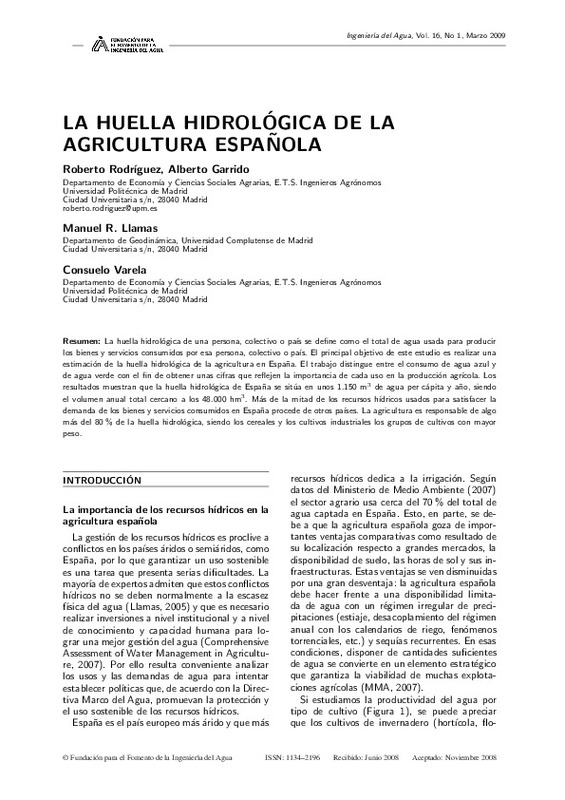Aldaya, M.M., (2007). How strategically important is green water in international crop trade. Dissertation for MSc in Environmental Policy and Regulation, London School of Economics.
Allan, J.A., (1998). Virtual Water: A Strategic Resource Global Solutions to Regional Deficits. Ground Water, 36, 545-546.
Allan, J.A., (2003). Virtual water eliminates water wars? A case study from the Middle East. En A.Y. Hoekstra (Ed.), Virtual Water Trade: Proceedings of the International Expert Meeting on Virtual Water Trade of Water Research Series, No.12, UNESCO-IHE, Delft, the Netherlands.
[+]
Aldaya, M.M., (2007). How strategically important is green water in international crop trade. Dissertation for MSc in Environmental Policy and Regulation, London School of Economics.
Allan, J.A., (1998). Virtual Water: A Strategic Resource Global Solutions to Regional Deficits. Ground Water, 36, 545-546.
Allan, J.A., (2003). Virtual water eliminates water wars? A case study from the Middle East. En A.Y. Hoekstra (Ed.), Virtual Water Trade: Proceedings of the International Expert Meeting on Virtual Water Trade of Water Research Series, No.12, UNESCO-IHE, Delft, the Netherlands.
Allen, R.G., Pereira, L.S., Raes, D. y Smith, M., (1998). Crop evapotranspiration: guidelines for computing crop water requirements. Irrigation and Drainage Paper, 56 FAO, Rome, 300 pp.
Brouwer C. y Heibloem Y., (1986). Irrigation water needs; Irrigation Water Management. Training Manual No 3, FAO, Rome, 62 pp.
Chapagain, A.K. y Hoekstra A.Y., (2003). Virtual water flows between nations in relation to trade in livestock and livestock products. Value of Water Research Series No. 13, UNESCO-IHE, Delft, the Netherlands.
Chapagain, A.K. y Hoekstra, A.Y., (2004). Water footprints of nations. Value of Water Research Series No. 16, UNESCO-IHE, Delft, the Netherlands.
Chapagain, A.K. y Hoekstra, A.Y., (2007). The water footprints of coffee and tea consumption in the Netherlands. Ecological Economics, 64, 109-118.
Chapagain, A.K., Hoekstra, A.Y., Savenije, H.H.G. y Gautam, R., (2006). The wáter footprint of cotton consumption: An assessment of the impact of worldwide consumption of cotton products on the wáter resources in the cotton producing countries. Ecological Economics, 60, 186-203.
Chapagain, A.K. y Orr, S., (in press). An improved water footprint methodology to link global consumption to local water resources: A case study of Spanish tomato consumption.
Comprehensive Assessment of Water Management in Agriculture, (2007). Water for Food, Water for Life: A Comprehensive Assessment of Water Management in Agriculture, Earthscan, London.
Falkenmark, M., (2003). Freshwater as shared between society and ecosystems: from divided approaches to integrated challenges. Philosophical Transactions of the Royal Society of London, Series B, Biological Sciences, 358, 2037-2049.
FAO, (2007). AQUASTAT. Food and Agriculture Organization. Rome, Italy. http://www.fao.org/ag/agl/aglw/aquastat/main/index.stm
Hoekstra, A.Y., (2007). Human appropriation of natural capital: Comparing Ecological Footprint and Water Footprint analysis. Value of Water Research Report Series No. 23, UNESCO-IHE, Delft, the Netherlands.
Hoekstra, A.Y. y Chapagain, A.K., (2007). The water footprints of Morocco and the Netherlands: Global water use as a result of domestic consumption of agricultural commodities. Ecological Economics, 64, 143-151.
Hoekstra, A.Y. y Hung, P.Q., (2002). Virtual water trade: a quantification of virtual water flows between nations in relation to international crop trade. Value of Water Research Report Series No. 11, UNESCO-IHE, Delft, the Netherlands.
INE, (2001). Estadística del Agua 1999. Gabinete de prensa, 8 de marzo del 2001, Instituto Nacional de Estadística.
INE, (2003). Encuesta sobre el suministro y tratamiento del agua 2001. Gabinete de prensa, 1 de julio del 2003, Instituto Nacional de Estadística.
INE, (2007a). Precipitación total en milímetros por región, estación, años y meses. Instituto Nacional de Estadística. http://www.ine.es/jaxi/tabla.do?path=/t43/a012/a1998/l0/&file=t20015b.px&type=pcaxis
INE, (2007b). Encuesta de población activa. Instituto Nacional de Estadística. http://www.ine.es/jaxi/menu.do?type=pcaxis&path=/t22/e308mnu&file=inebase&N=&L=0
INM, (2007). Series mensuales de evapotranspiración potencial y precipitación para los puntos registrados de la España Peninsular. Años 1996-2007, Instituto Nacional de Meteorología, Ministerio de Medio Ambiente.
Llamas, M.R., (2005). Los colores del agua, el agua virtual y los conflictos hídricos. Discurso Inaugural del Curso 2005/2006, Real Academia de Ciencias Exactas, Madrid, España, 30 pp.
MAPA, (2001). Calendario de siembra, recolección y comercialización, años 1996-1998. Ministerio de Agricultura, Pesca y Alimentación, Madrid, España, 656 pp.
MAPA, (2003). Libro Blanco de la Agricultura y el Desarrollo Rural. Ministerio de Agricultura, Pesca y Alimentación, Madrid, España. Formato electrónico en: www.libroblancoagricultura.com
MAPA, (2005) Anuario de Estadística Agroalimentaria. Ministerio de Agricultura, Pesca y Alimentación, Madrid, España. Varios años (2003,2001,1998). http://www.mapa.es/es/estadistica/pags/anuario/introduccion.htm
MMA, (2007) El agua en la economía española: Situación y perspectivas. Informe integrado del análisis económico de los usos del agua. Artículo 5 y Anejos II y III de la Directiva Marco del Agua. Ministerio de Medio Ambiente, Madrid, España, 290 pp.
Novo Núñez, P., (2008). Análisis del "comercio" de agua virtual en España: Aplicación al caso de los cereales. Trabajo Final de Carrera en la E.T.S. Ingenieros Agrónomos, Madrid, España.
Roth, E., Rosenthal, H. y Burbridge, (2001). A discussion of the use of the sustainability index: "ecological footprint" for aquaculture production. Aquatic Living Resources, 13, 461-469.
Wackernagel, M., Onisto, L., Linares, A.C., Falfan, I.S.L., Garcia, J.M., Guerrero, I.S. y Guerrero, M.G.S., (1997). Ecological footprints of nations: How much nature do they use?- How much nature do they have? Centre for Sustainability Studies, Universidad Anahuac de Xalapa.
Wackernagel, M. y Rees, W., (1996). Our Ecological Footprint: Reducing human impact on the earth. Gabriola Island, BC: New Society Publishers, ISSN-1192-1285.
Yang, H. y Zehnder, A.J.B., (2002). Water Scarcity and Food Import: A Case Study for Southern Mediterranean Countries. World Development, 30, 1413-1430.
[-]








